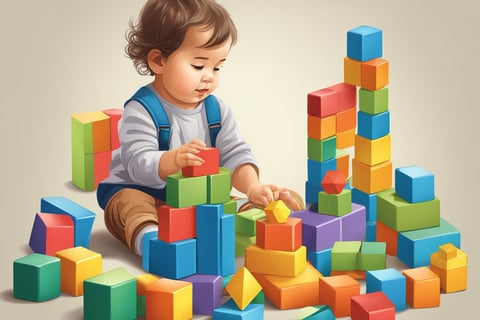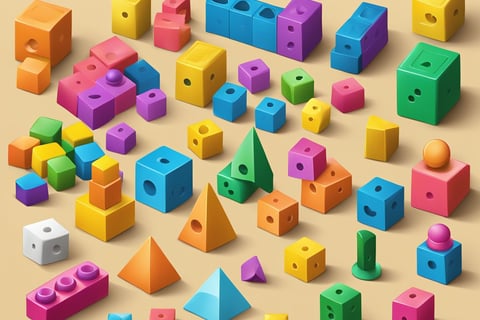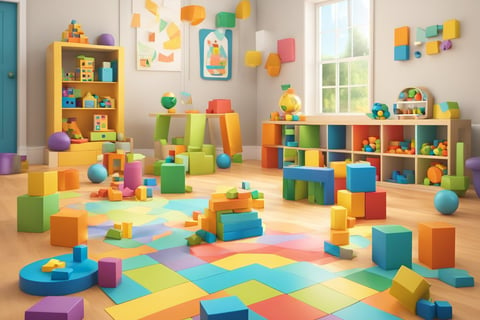Building Foundational Math Skills for Toddlers: A Practical Guide
Learn how to introduce essential math concepts like counting, shapes, and spatial awareness to toddlers. Discover practical activities and tips for building a strong foundation.
MATHMATH TODDLERS
11/22/20245 min read
Key Math Concepts for Toddlers: Building Foundational Skills
In the world of early childhood education, introducing math concepts to toddlers is essential for their cognitive development. It's never too early to start, as children can begin to understand basic ideas like counting, shapes, and patterns through everyday interactions and playful activities. Providing these foundational skills helps toddlers develop problem-solving abilities and critical thinking, setting the stage for lifelong learning.
Toddlers are naturally curious, and their eagerness to explore the world around them creates a perfect opportunity to introduce math in a meaningful way. Using simple activities with toys, blocks, or daily routines, caregivers and educators can integrate math into a child's life seamlessly. This engaging approach can spark an interest in math that continues throughout their education.
Using games and storytelling can make math relatable and fun for toddlers. Incorporating math language in day-to-day conversations and encouraging hands-on activities help build a strong foundation. These experiences provide toddlers with the tools they need to confidently approach math in the future.
Counting
Counting forms the foundation of math understanding for toddlers. It introduces children to the concept of numbers and their sequence in a natural and engaging way.
Basic Techniques:
Rote counting: Encourage toddlers to recite numbers in order. This helps develop memorization and familiarity with the sequence of numbers.
Object counting: Use everyday objects like toys or blocks. Ask children to count items one by one to connect numbers with quantities.
Interactive Activities:
Nursery rhymes: Songs and rhymes with numbers make counting fun. They capture attention and aid retention.
Counting games: Engage toddlers with games that involve counting out loud or finding a specific number of items. These reinforce the relationship between numbers and amounts.
Practical Tips:
Integrate counting into daily routines. Encourage counting steps, snacks, or during cleanup. This ties counting to real-life situations and increases practicality.
Praise and encouragement motivate toddlers to enjoy counting. Positive reinforcement enhances their confidence in their abilities.
Parents and caregivers play a crucial role in supporting toddlers' counting activities. Creating a lively and supportive environment fosters a love for numbers and lays the groundwork for future math skills.
Shapes
Introducing toddlers to shapes builds a foundation for geometry. Recognizing shapes helps with understanding the world and aids in cognitive development.
Basic Shapes Include:
Circle: A round shape with no corners.
Square: Four equal sides and four right angles.
Triangle: Three sides and corners.
Toddlers benefit from play using shape toys. Puzzles and blocks help them identify and classify shapes effectively.
Practical tips include: Letting them engage with everyday objects to identify shapes. A ball is a circle, a book is a rectangle, and a sandwich can be a triangle. Talking about these shapes reinforces learning.
Colorful books that feature shape activities engage toddlers and make learning enjoyable. A routine including shape-finding games encourages active participation.
Shapes also involve pattern recognition. Observing repeating patterns of shapes improves memory and observational skills. This can be done through activities like drawing or using stickers.
Encouraging children to draw their favorite shapes helps with motor skills. Providing crayons and paper allows them to express their understanding creatively.
Shapes are present everywhere. A walk outside to spot different shapes creates an interactive learning experience and makes the concept relatable.
Spatial Awareness
Spatial awareness involves recognizing and understanding the position of objects in relation to oneself and the environment. It is a fundamental math concept for toddlers.
Activities for Developing Spatial Awareness:
Building Blocks: Encourage toddlers to stack and align blocks. This helps them grasp concepts like height, width, and balance.
Puzzles: Simple puzzles teach toddlers how pieces fit together, enhancing their understanding of how shapes and spaces interact.
Obstacle Courses: Navigating around obstacles boosts a child's perception of distance and space.
Language and Spatial Awareness:
Using words like above, below, next to, and between can help toddlers learn spatial relationships. This helps in everyday activities and simple math problems.
Visual Aids:
Pictures and drawings with labeled spatial terms can help children visualize positions. These tools make learning more interactive and enjoyable.
Games:
Interactive games that require children to find or move items to specific locations can improve spatial reasoning. Consider games like "Simon Says" with directions involving spatial terms.
Benefits of Spatial Awareness:
Developing these skills aids in fields like geometry and enhances problem-solving abilities. Encouraging early development of spatial awareness sets a strong foundation for future learning.
Measurement
Measurement is a fundamental math concept for toddlers. It helps them grasp the idea of size, length, weight, and capacity by exploring the world around them. Simple activities can make these concepts clearer and more engaging.
Consider introducing length by comparing everyday objects. For instance, a child can identify which of two pencils is longer by placing them side by side. This visual comparison builds a basic understanding of measurement.
Weight can be explored through play with objects of differing heaviness. Let children hold a sponge and a stone to feel the difference. Ask them which is heavier and which is lighter, encouraging them to use those terms.
Using simple tools like a measuring cup when playing with water or sand introduces the concept of capacity. Fill two different containers and discuss which holds more or less. Discussions like these illustrate varying capacities.
Height is another aspect of measurement. Engage toddlers in measuring their own height using a wall chart. These activities integrate fun and learning, allowing them to grasp the concept of height.
To visual learners, charts and pictures act as valuable aids. Create a simple chart comparing different items by size or weight to reinforce these ideas visually.
Using everyday experiences makes measurement relatable. Encourage asking questions: "Is the book taller than the toy?" Simple questions ensure toddlers begin to measure objects informally, laying the groundwork for understanding complex concepts later on.
Patterns
Recognizing patterns is an essential skill for toddlers as it lays the groundwork for more complex mathematical concepts. Patterns help children identify relationships and make predictions. Engaging with patterns enhances problem-solving abilities.
Simple Patterns: Toddlers can start by identifying and creating simple repeating patterns. Examples include alternating colors like red, blue, red, blue, or shapes like circle, square, circle, square.
Utilizing everyday objects such as toys, blocks, or even snacks can make pattern recognition fun. For instance, arranging toy cars in a specific color sequence engages their attention and encourages active participation.
Activities for Reinforcement:
Clap and Stomp: Create rhythm patterns through clapping and stomping. For example, clap, clap, stomp, repeat.
Art Projects: Use crayons or paint to create visual patterns on paper.
Introducing pattern-based games or puzzles can further enrich a child's experience. Games that involve matching socks or finding the next item in a sequence are not only enjoyable but educational.
Adults can guide children by asking questions such as "What comes next?" or "Do you see a pattern?" Encouraging toddlers to describe patterns they see around them fosters communication and critical thinking.
Incorporating patterns in daily routines assists toddlers in becoming attentive observers. Whether it’s arranging dining utensils or selecting outfits, finding patterns in these activities helps cultivate both creativity and logical thinking.








Counting
Shapes
Spatial Awareness
Measurement
Patterns
Explore
Discover engaging educational toys and learning tools.
Contact Us
thescholarlysandbox@outlook.com
© 2025. All rights reserved.
Affiliate disclosure: As an Amazon Associate, we may earn commissions from qualifying purchases from Amazon.com.
